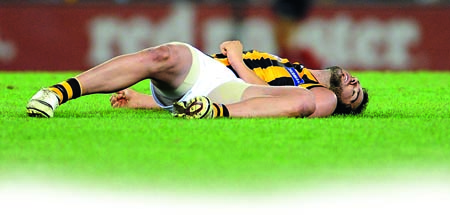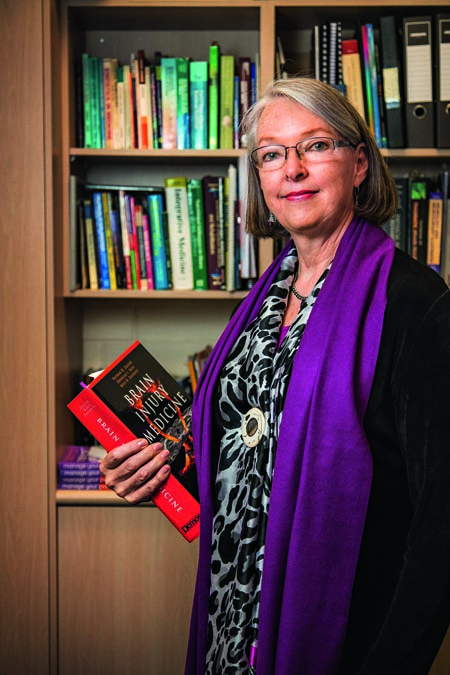Protecting the head a game changer
Shortly after Sandy Shultz arrived in Melbourne from Canada in 2010, he observed with professional interest the kerfuffle that followed Jordan Lewis being knocked unconscious while playing for Hawthorn. As Lewis lay prone on the turf it was hard to imagine he could be cleared to play just six days later – let alone return to the field that afternoon, as he did to widespread alarm. By Peter Hanlon
“It was quite striking how far behind the concussion management was versus the North American sports,” recalls Dr Shultz, an associate professor at the Melbourne Brain Centre, University of Melbourne. “But in the past five or six years, the AFL has done an excellent job in implementing new rules that facilitate better on-field and in-game diagnosis. There’s clear guidelines and protocol. I think a lot of progress has been made.”
The sight of Geelong’s captain and renowned battering ram Joel Selwood being forced to watch from the sidelines after he was knocked out in the opening minute of this year’s Round 14 game against Fremantle – not just for the remainder of the afternoon, but the following week, too – underscores Dr Shultz’ observation of a shift towards greater caution in the AFL. Yet the issue of concussion in elite sport can still seem as complex and as sensitive as the brain itself.
Miranda Jelbart, of the Hampstead Rehabilitation Centre’s Concussion Clinic, in Adelaide, agrees that policing of the “five Rs” in concussion management – recognise, removal, referral, rest, return – is vastly improved. She also concurs with Dr Shultz that American sports have set a benchmark in treating every injury individually, rather than lumping them under a single heading.
Research at Buffalo State University anchored around treadmill testing has been significant. “They put athletes who have had concussions into training regimes on the treadmill,” says Dr Jelbart (MB BS 1975, Trinity College, Janet Clarke Hall). “They find that the athletes cannot achieve a maximal pulse rate to match their pre-injury levels, and often they have to stop due to onset of headaches, profound fatigue or nausea.
“With regular re-testing and gradual upgrading of exercise intensity, and keeping below what triggers adverse symptoms, the athlete can build up exercise tolerance and return successfully to training and play.”
Sudden ballistic head injury can stretch nerve fibres at vulnerable regions, such as the brainstem, causing altered control of the body’s automatic functions such as pulse rate, blood flow and blood pressure. It takes time for healing, and for symptoms to abate.
Jordan Lewis’s experience in 2010 supports the need for patience. Out of competition, footballers are subjected to cognitive testing such as the SCAT (Standard Concussion Assessment Tool), and other tasks such as reciting numbers or months of the year backwards, along with checks of mental precision. Questions about venue, stage and state of the game are added on game day, and additional cognitive testing may be undertaken before the athlete is cleared to play. Lewis’s results married up with his baseline, but in the weeks following his concussion he admitted his decision-making was hampered in the high intensity environment of an AFL game.
International “brain banks” have been set up to conduct vital research by analysing brain tissue from deceased athletes which has revealed more about the risks of chronic traumatic encephalopathy. Historically, a form of this was called being “punch drunk” in boxers, caused by repeated head trauma. Blast injury is now also recognised as a cause of brain trauma in soldiers returning from combat zones.
There have been calls for a “three strikes” policy in some sports, where three concussions in one athlete would spell the end of their career. Dr Shultz sees potential merit in an amateur sport trial, and barriers to such a blanket approach at higher levels. “When it comes to professional athletes in particular, to choose a somewhat arbitrary number and start making mandatory decisions that affect their livelihoods, I’m hesitant to endorse that without evidence.”
In a nutshell, Dr Shultz says, we need an evidence-based approach to concussion, territory that’s made all the more difficult by the fact that every brain is different, as is every recovery from brain trauma. This explains why Joel Selwood missed a week with concussion, yet later in the AFL season Adelaide’s Rory Sloane played just six days after a similar injury.
The extent of brain injury depends on speed, impact and forces involved in the blow to the head. “A living brain is so delicate, imagine it to be the texture of lightly set jelly, not solid at all,” Dr Jelbart explains. “If you accelerate it and then stop it suddenly, the delicate nerve fibres that hold the ‘jelly’ together can be stretched or torn, or surface bruising can occur. In head trauma, the brain keeps travelling inside the skull; that’s when damage occurs.”
Read our full story on sports medicine.




